哈工大航天学院课程-空间飞行器动力学与控制-第1课-绪论
- 格式:ppt
- 大小:3.15 MB
- 文档页数:79

Nanjing University of Aeronautics and Astronautics Spacecraft Dynamics and Control Teacher:Han-qing ZhangCollege of AstronauticsSpacecraft Dynamics and Control Text book:Spacecraft Dynamics andControl:A PracticalEngineering Approach/s/1o6BF32U(1) Wertz, J. R. Spacecraft Orbit and Attitude Systems, Springer. 2001(2) 刘墩.空间飞行器动力学,哈尔滨工业大学出版社,2003.(3) 章仁为.卫星轨道姿态动力学与控制,北京航空航天大学出版社,2006.(4) 基于MATLAB/Simulink的系统仿真技术与应用,清华大学出版社,2002。
2014年4月22日星期二Spacecraft Dynamics and ControlSpacecraft Dynamics and Control 1. IntroductionSpace technology is relatively young compared to other modern technologies, such as aircrafttechnology.In only forty years this novel domain hasachieved a tremendous level of complexity andsophistication. The reason for this is simplyexplained: most satellites, once in space, must rely heavily on the quality of their onboardinstrumentation and on the design ingenuity of the scientists and engineers.2014年4月22日星期二Spacecraft Dynamics and ControlSpacecraft Dynamics and Control The desire of humans to conquer space within the solar system will surely encourage newtechnological achievements that are not yetimagined.The technical fields in which satellites are used are numerous一telecommunications, scientificresearch, meteorology, and others.According to the specific task for which they are designed, satellites may be in orbits as low as200 km or as high as 40,000 km above the earth;other spacecraft leave the earth toward planets in the solar system2014年4月22日星期二Spacecraft Dynamics and ControlSpacecraft Dynamics and Control In October 4, 1957, the former Soviet Union sent the world's first artificial satellite into space.In March 11, 1960, the United States launcheda "pioneer" detector,and it was known as thefirst deep-space probe.2014年4月22日星期二Spacecraft Dynamics and Control2014年4月22日星期二Spacecraft Dynamics and ControlSpacecraft Dynamics and ControlIn April 12, 1961,the former SovietUnion successfullylaunched the firstmanned spacecraft. 尤里·加加林Spacecraft Dynamics and ControlIn March 1965, the former Soviet Union realized the first human spacewalk.“上升号”载人飞船2014年4月22日星期二Spacecraft Dynamics and ControlSpacecraft Dynamics and ControlIn January 1966, two spacecrafts completed the rendezvous and docking successfully for the first time in the former Soviet Union .“联盟号”飞船2014年4月22日星期二Spacecraft Dynamics and ControlSpacecraft Dynamics and ControlIn July 1969, the United States landed on the moon for the first time.N.A.阿姆斯特朗E.E.奥尔德林2014年4月22日星期二Spacecraft Dynamics and ControlSpacecraft Dynamics and ControlIn April 19, 1971, the first space station was built successfully with regard to the former Soviet.“和平号”轨道空间站2014年4月22日星期二Spacecraft Dynamics and ControlSpacecraft Dynamics and ControlIn April 1981, the first space shuttle had the successful test flight.“哥伦比亚号”航天飞机首飞记录片2014年4月22日星期二Spacecraft Dynamics and ControlSpacecraft Dynamics and ControlFengYun22014年4月22日星期二Spacecraft Dynamics and ControlSpacecraft Dynamics and Control北斗导航试验卫星定位原理图2014年4月22日星期二Spacecraft Dynamics and ControlSpacecraft Dynamics and Control Satellites may be very heavy: an inhabited space station, for example, could weigh severaltons or more. There also exist very light satellites, weighing 20 kg or less. Small satellites may berelatively cheap.Despite their differences, satellites possess fundamental features that are common to all. The physical laws that govern their motion in spaceand their dynamics are the same for all spacecraft.Hence, the fundamental technologies that evolved from these laws are common to all.2014年4月22日星期二Spacecraft Dynamics and ControlSpacecraft Dynamics and ControlA satellite's life begins with the specificbooster transferring it to some initial orbit,called a transfer orbit, in which the satellite is already circling the earth.For a satellite that will stay near earth, the next stage will be to "ameliorate" theorbit. This means that the satellite must bemaneuvered to reach the precise orbit forwhich the satellite was designed to fulfill its mission.2014年4月22日星期二Spacecraft Dynamics and ControlSpacecraft Dynamics and Control Next, the satellite's software must check for the proper functioning of itsinstrumentation and its performance inspace, as well as calibrate some of theinstruments before they can be used tocontrol the satellite.The final stage is the one for which the satellite was designed and manufactured.2014年4月22日星期二Spacecraft Dynamics and ControlSpacecraft Dynamics and Control Understanding the meaning of each stage will help one to understand the infrastructure of thecontrol system of any satellite.Throughout the text, the terms "satellite" and "spacecraft" (s/c for short) will be usedinterchangeably. The terms "geosynchronous"and "geostationary" will be used interchangeably to describe the orbit of a satellite whose period can be made exactly equal to the time it takes theearth to rotate once about its axis.2014年4月22日星期二Spacecraft Dynamics and ControlSpacecraft Dynamics and ControlA geosynchronous communications satellitewill be described in its different life stages. Acommon, medium-sized satellite is good example.Satellite of this type consist of the following main structural parts.(1) A central body consisting of a cubelikestructure.(2) Solar arrays extended in the N-S direction.(3) An antenna tower directed toward theearth.(4) Controllers(such as reaction thrusters)and attitude sensors(such as sun sensors).2014年4月22日星期二Spacecraft Dynamics and ControlSpacecraft Dynamics and ControlAttitude and orbit control systemThe attitude and orbit control system (AOCS) may include:(1) A reaction bipropellant (反应双组元)thrustsystem.(2) Two momentum wheels (one redundant).2014年4月22日星期二Spacecraft Dynamics and ControlSpacecraft Dynamics and Control(3) Two infrared horizon sensors. (one operating andone redundant)(4) Four fine sun sensors. (two redundant)(5)Twelve coarse sun sensors for safety reasons. (sixredundant)(6)Two three-axis coarse rate gyros(陀螺仪).(7)Two three-axis integrating gyros.2014年4月22日星期二Spacecraft Dynamics and ControlSpacecraft Dynamics and Control Much of the control hardware is redundant in order to guarantee a reliable control systemdespite potential hardware failures.2014年4月22日星期二Spacecraft Dynamics and ControlSpacecraft Dynamics and ControlMission sequenceSequence for injecting a satellite into the geostationary orbit.2014年4月22日星期二Spacecraft Dynamics and ControlSpacecraft Dynamics and ControlFirst is the launch into ageosynchronous transfer orbit(GTO).(地球同步转移轨道)withperigee and apogee (low and highaltitude) of 200 km and 35,786km, respectively.This is followed by the transferfrom GTO to geostationary orbit(GEO)(地球同步静止轨道),whereperigee and apogee both are35,786 km and the orbitinclination and eccentricity areclose to null.2014年4月22日星期二Spacecraft Dynamics and ControlSpacecraft Dynamics and ControlNext is the preparationand calibration of theAOCS.(姿态和轨道控制系统)GEO mission can start,followed by the actualGEO mission stage.2014年4月22日星期二Spacecraft Dynamics and ControlSpacecraft Dynamics and ControlAfter separation from the launcher, the satellite is commanded into a sun acquisition mode with the -X B axis pointing toward the sun. After completion of this stage, the solar panels are partially or fully deployed. If fully deployed, They can be rotated about their axis of rotation toward the sun in order to maximize power absorption.2014年4月22日星期二Spacecraft Dynamics and ControlSpacecraft Dynamics and ControlThe satellite stays in this cruise mode until the first apogee boost motor (ABM) orbit is approached. In the first and the subsequent ABM orbits, several hours before the ABM firing at the apogee, the gyros' calibration maneuvers are initiated.2014年4月22日星期二Spacecraft Dynamics and ControlSpacecraft Dynamics and ControlLess than an hour before any ABM firing, earth acquisition is initiated with the +Z B axis now pointed toward the earth, followed by preparation for the ABM firing stage.2014年4月22日星期二Spacecraft Dynamics and ControlSpacecraft Dynamics and ControlAfter ABM firings ranging from several to more than 30 minutes, the satellite is commanded to GTO cruise. After the last ABM firing, the satellite life is prepared for GEO operation.2014年4月22日星期二Spacecraft Dynamics and ControlSpacecraft Dynamics and ControlIn the first GEO, earth acquisition is performed, meaning that the +Z B axis of the satellite is directed toward the earth center of mass, thus allowing the normal GEO cruise.2014年4月22日星期二Spacecraft Dynamics and ControlSpacecraft Dynamics and ControlThe momentum wheel is spun to its nominal angular velocity to provide momentum bias attitude control. The orbit is then corrected for any remaining inaccuracies in inclination and eccentricity.2014年4月22日星期二Spacecraft Dynamics and ControlSpacecraft Dynamics and ControlThe satellite orbit dynamics and controlThe classical equations of motion of ideal Keplerian orbits.The basic orbital control concepts including control and station keeping of satellites.The attitude dynamics and controlThe basic equations of rotational motion about some axis through its center of mass.Single-and Dual-spin stabilization.The attitude stabilization and maneuvering ofspacecraft stabilized in three axes.2014年4月22日星期二Spacecraft Dynamics and Control。
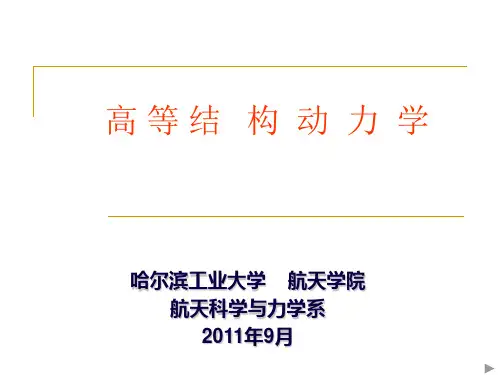
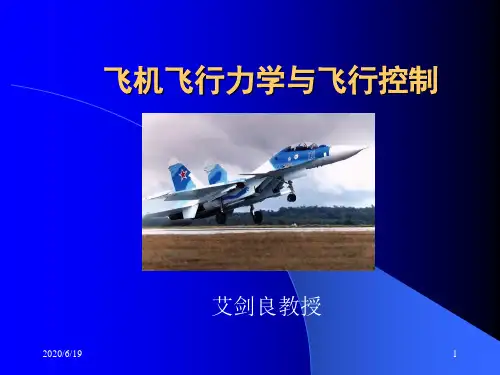
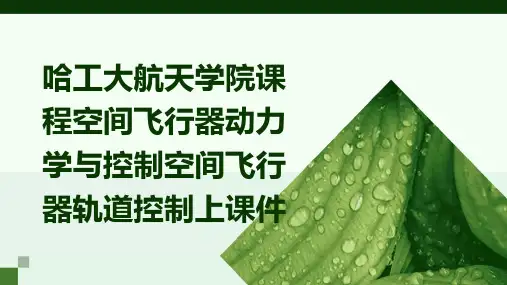
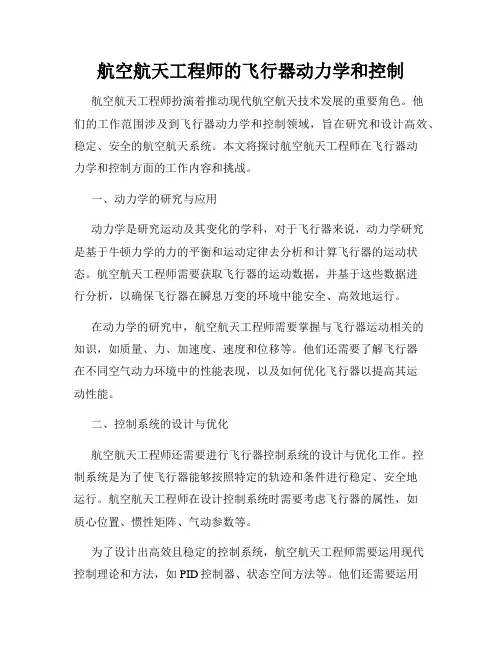
航空航天工程师的飞行器动力学和控制航空航天工程师扮演着推动现代航空航天技术发展的重要角色。
他们的工作范围涉及到飞行器动力学和控制领域,旨在研究和设计高效、稳定、安全的航空航天系统。
本文将探讨航空航天工程师在飞行器动力学和控制方面的工作内容和挑战。
一、动力学的研究与应用动力学是研究运动及其变化的学科,对于飞行器来说,动力学研究是基于牛顿力学的力的平衡和运动定律去分析和计算飞行器的运动状态。
航空航天工程师需要获取飞行器的运动数据,并基于这些数据进行分析,以确保飞行器在瞬息万变的环境中能安全、高效地运行。
在动力学的研究中,航空航天工程师需要掌握与飞行器运动相关的知识,如质量、力、加速度、速度和位移等。
他们还需要了解飞行器在不同空气动力环境中的性能表现,以及如何优化飞行器以提高其运动性能。
二、控制系统的设计与优化航空航天工程师还需要进行飞行器控制系统的设计与优化工作。
控制系统是为了使飞行器能够按照特定的轨迹和条件进行稳定、安全地运行。
航空航天工程师在设计控制系统时需要考虑飞行器的属性,如质心位置、惯性矩阵、气动参数等。
为了设计出高效且稳定的控制系统,航空航天工程师需要运用现代控制理论和方法,如PID控制器、状态空间方法等。
他们还需要运用数学建模和仿真软件来评估控制系统的性能,以使飞行器具有良好的稳定性和操纵性。
三、飞行器动力学与控制的挑战航空航天工程师在飞行器动力学和控制领域面临着许多挑战。
首先,不同类型的飞行器,如飞机、直升机、火箭等,其动力学特性和控制要求都有所不同,要求工程师有针对性地进行研究和设计。
其次,飞行器的非线性特性和不确定性因素,如外部气动因素、动力系统失效等,给飞行器的动力学和控制带来了很大的复杂性。
航空航天工程师需要运用先进的控制理论和方法,以应对这些复杂性,并确保飞行器的安全运行。
最后,随着航空航天技术的不断发展,新的飞行器设计和控制技术不断涌现,这也对航空航天工程师的专业知识和技能提出了更高的要求。
![飞行器结构动力学_第1章_2014版 [兼容模式]](https://uimg.taocdn.com/1a6d4b0ede80d4d8d15a4f4f.webp)
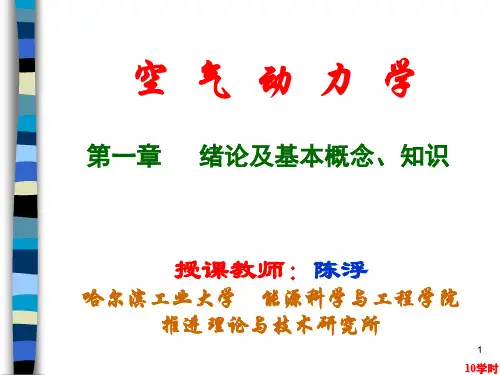
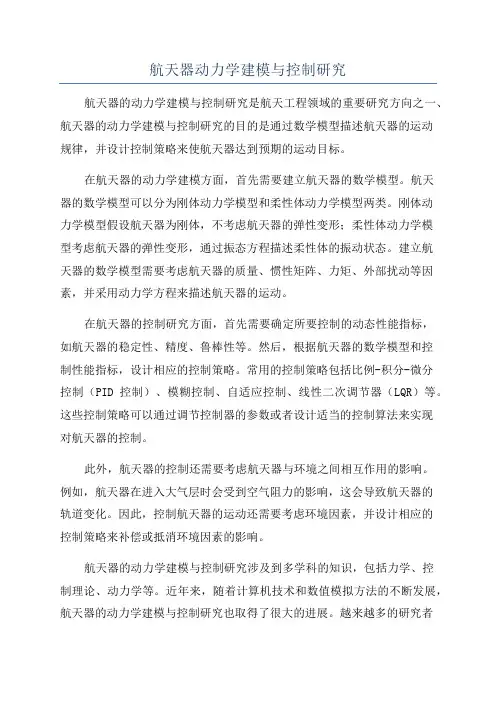
航天器动力学建模与控制研究航天器的动力学建模与控制研究是航天工程领域的重要研究方向之一、航天器的动力学建模与控制研究的目的是通过数学模型描述航天器的运动规律,并设计控制策略来使航天器达到预期的运动目标。
在航天器的动力学建模方面,首先需要建立航天器的数学模型。
航天器的数学模型可以分为刚体动力学模型和柔性体动力学模型两类。
刚体动力学模型假设航天器为刚体,不考虑航天器的弹性变形;柔性体动力学模型考虑航天器的弹性变形,通过振态方程描述柔性体的振动状态。
建立航天器的数学模型需要考虑航天器的质量、惯性矩阵、力矩、外部扰动等因素,并采用动力学方程来描述航天器的运动。
在航天器的控制研究方面,首先需要确定所要控制的动态性能指标,如航天器的稳定性、精度、鲁棒性等。
然后,根据航天器的数学模型和控制性能指标,设计相应的控制策略。
常用的控制策略包括比例-积分-微分控制(PID控制)、模糊控制、自适应控制、线性二次调节器(LQR)等。
这些控制策略可以通过调节控制器的参数或者设计适当的控制算法来实现对航天器的控制。
此外,航天器的控制还需要考虑航天器与环境之间相互作用的影响。
例如,航天器在进入大气层时会受到空气阻力的影响,这会导致航天器的轨道变化。
因此,控制航天器的运动还需要考虑环境因素,并设计相应的控制策略来补偿或抵消环境因素的影响。
航天器的动力学建模与控制研究涉及到多学科的知识,包括力学、控制理论、动力学等。
近年来,随着计算机技术和数值模拟方法的不断发展,航天器的动力学建模与控制研究也取得了很大的进展。
越来越多的研究者利用数值模拟方法对航天器的动力学特性进行分析和优化,并设计出更加精确和高效的控制策略。
总之,航天器的动力学建模与控制研究是航天工程中的重要内容,通过数学模型和控制策略的设计,可以实现对航天器运动的精确控制,提高航天器的运行稳定性和控制精度。
随着人类对航天事业的不断追求与发展,航天器的动力学建模与控制研究将会在未来得到更加广泛的应用和深入的研究。
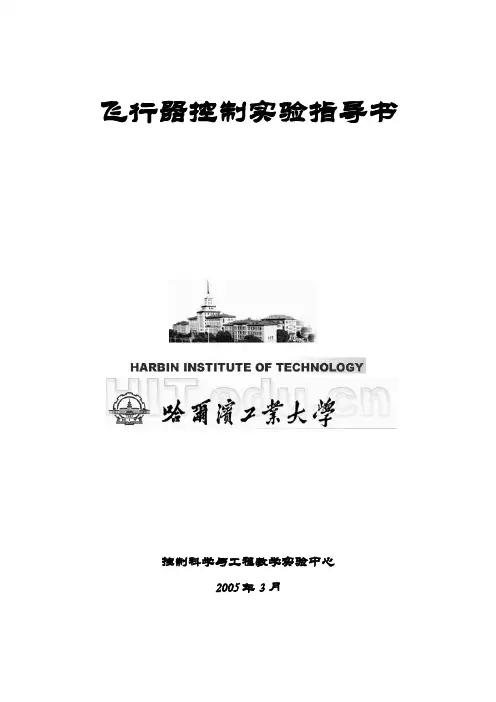
飞行器控制实验指导书控制科学与工程教学实验中心2005年3月目录一、实验目的和意义二、实验的基本要求三、Matlab语言基础四、实验项目(一) 实验一飞行器纵向稳定系统综合设计(二) 实验二飞行器侧向稳定器观测器的设计(三) 实验三飞行器爬升率与空速的保持与指令控制(四) 实验四飞行器3维飞行动画仿真实验一、实验目的和意义作为航天学院的学生,掌握飞行器控制方面的知识是必要的。
仅仅通过课堂教学,学生很难切实地掌握飞行器控制的知识,很难熟练地应用飞行器控制的方法。
为了使学生更深刻地理解飞行器控制方面的知识,开设本实验是必要的。
通过飞行器控制实验,可以使学生更直观地理解课堂上学到的理论,使学生能真正做到理论与实际相结合,会应用课堂上所学到的理论来进行飞行器控制系统的设计,同时,使学生掌握用Matlab来进行飞行器控制系统分析与设计的方法。
二、实验的基本要求1.要求学生能较熟练地使用控制系统分析设计软件(Matlab)来进行系统分析与设计。
2.要求学生能熟练地使用Matlab软件进行编程,并在该软件环境下进行调试。
3.要求学生掌握模态控制理论(模态可控、模态可观结构分析;模态控制器设计,模态观测器设计),并编制相应的matlab函数。
4.要求学生能使用所编制的程序进行飞行器控制系统的分析与综合。
三、Matlab语言基础(一) matlab软件的编程环境1.找到MatlabMatlab软件应用程序的图标为,matlab软件被正确安装后,可以将该图标拖曳到桌面上或快捷工具栏中以方便使用。
2.启动Matlab点击Matlab图标会弹出如下窗口(二) 飞行器控制实验中要用到的matlab语句1.赋值语句:A=[0 1 0;0 0 1;-6 -11 -6]2.矩阵的维数:[行,列]=size(A)3.矩阵的秩:n=rank(A)4.矩阵的逆:B=inv(A)5.求特征值和特征向量:[V,eva]=eig(A') V为A T的广义模态矩阵,eva=diag(λ1,…,λn)6.矩阵的转置:A因为是实数阵所以转置可以用A’,A’是A的共扼转置而U,V等复数阵的转置要用conj(V’);7.子阵的抽取:A(i:j,m:n); A(:,1);A(i,j)8.矩阵四则运算:(维数要一致)表达式与标量数值运算同9.循环语句:for i=1:1:n+1程序行end10.条件判断:if(a~=b)程序行end11.结果显示控制:语句后面加“;”则不显示结果。
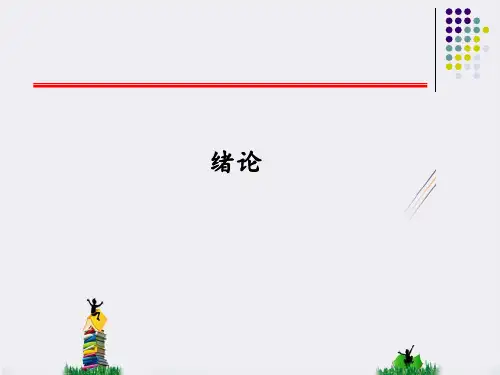
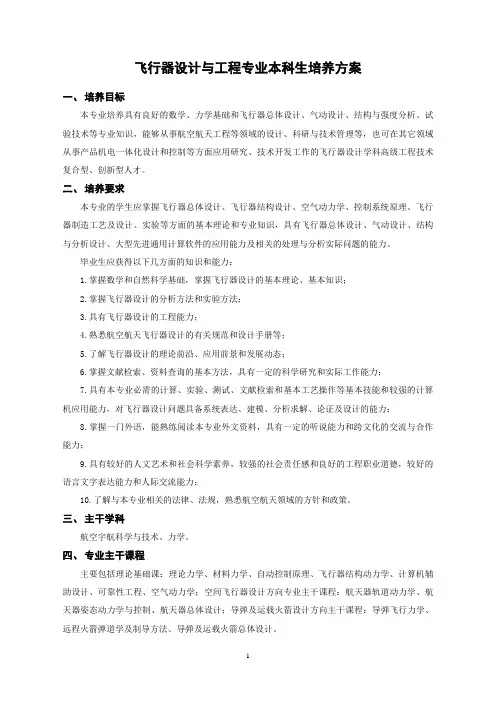
飞行器设计与工程专业本科生培养方案一、培养目标本专业培养具有良好的数学、力学基础和飞行器总体设计、气动设计、结构与强度分析、试验技术等专业知识,能够从事航空航天工程等领域的设计、科研与技术管理等,也可在其它领域从事产品机电一体化设计和控制等方面应用研究、技术开发工作的飞行器设计学科高级工程技术复合型、创新型人才。
二、培养要求本专业的学生应掌握飞行器总体设计、飞行器结构设计、空气动力学、控制系统原理、飞行器制造工艺及设计、实验等方面的基本理论和专业知识,具有飞行器总体设计、气动设计、结构与分析设计、大型先进通用计算软件的应用能力及相关的处理与分析实际问题的能力。
毕业生应获得以下几方面的知识和能力:1.掌握数学和自然科学基础,掌握飞行器设计的基本理论、基本知识;2.掌握飞行器设计的分析方法和实验方法;3.具有飞行器设计的工程能力;4.熟悉航空航天飞行器设计的有关规范和设计手册等;5.了解飞行器设计的理论前沿、应用前景和发展动态;6.掌握文献检索、资料查询的基本方法,具有一定的科学研究和实际工作能力;7.具有本专业必需的计算、实验、测试、文献检索和基本工艺操作等基本技能和较强的计算机应用能力,对飞行器设计问题具备系统表达、建模、分析求解、论证及设计的能力;8.掌握一门外语,能熟练阅读本专业外文资料,具有一定的听说能力和跨文化的交流与合作能力;9.具有较好的人文艺术和社会科学素养,较强的社会责任感和良好的工程职业道德,较好的语言文字表达能力和人际交流能力;10.了解与本专业相关的法律、法规,熟悉航空航天领域的方针和政策。
三、主干学科航空宇航科学与技术、力学。
四、专业主干课程主要包括理论基础课:理论力学、材料力学、自动控制原理、飞行器结构动力学、计算机辅助设计、可靠性工程、空气动力学;空间飞行器设计方向专业主干课程:航天器轨道动力学、航天器姿态动力学与控制、航天器总体设计;导弹及运载火箭设计方向主干课程:导弹飞行力学、远程火箭弹道学及制导方法、导弹及运载火箭总体设计。
《空间飞行器飞行动力学》课程教学大纲课程编码: T1180230课程中文名称:空间飞行器飞行动力学课程英文名称:SPACECRAFT DYNAMICS总学时:50 讲课学时:50 实验学时:0习题学时:0 上机学时:0学分:3授课对象:飞行器设计专业、空间环境专业本科生先修课程:高等数学、普通物理、理论力学、自动控制理论教材及参考书:《空间飞行器动力学》,刘暾. 赵钧,哈尔滨工业大学出版社《空间飞行器动力学与控制》,M.H.卡普兰一、课程教学目的《空间飞行器动力学》是一门航天工程专业学生的专业基础课。
本课程主要研究空间飞行器动力学的基本概念、原理和应用,包括轨道动力学和姿态动力学两大部分,其主要任务是培养学生:建立空间飞行器动力学的基本概念,理解飞行器的运动与受力之间的关系,掌握空间飞行器动力学问题的基本分析方法;掌握应用空间飞行器动力学的基本理论,解决一般的空间飞行器动力学应用问题的基本技能;了解空间飞行器动力学理论、方法及其应用的最新发展;掌握使用相关的参考文献、计算机应用软件进行动力学问题研究分析的能力;《空间飞行器动力学》是高等工科院校中航天工程类专业的一门主要课程。
通过该课程的学习,学生可以初步掌握解决空间飞行器动力学问题的基本方法和技能,并了解其他空间飞行器应用问题的动力学依据,为日后从事空间飞行器的动力学及其他的空间飞行器应用专业的研究工作奠定初步的理论基础。
二、教学内容及基本要求轨道动力学部分(上篇)第一章绪论(1学时)概论,齐奥尔科夫斯基公式,单级火箭的极限速度。
第二章空间飞行器的入轨(1学时)运载火箭的运动方程式,纵向平面内的动力学方程,运载火箭导引规律。
第三章空间飞行器的轨道(4学时)两体运动方程的建立、求解,中心引力场中的运动,四种基本轨道的轨道方程、特性及时间方程。
第四章轨道的建立和星下点轨迹(2学时)空间飞行器轨道建立的方法,轨道要素与发射参数的关系,星下点轨迹的描述。